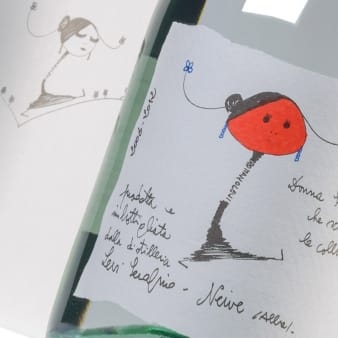-
![Grappa Paglierina <br>Selezione limitata N°1 <br>in gift box]()
Grappa Paglierina · Selezione limitata N°1 · in gift box
The famous Romano Levi distillery was bought by an old friend of Levi and an investor from the town of Neive after his death (1 May 2010). Their aim is to maintain the tradition, art and spirit of Romano Levi in Neive. Today, the old distillery has been completely renovated and converted into a museum. The new owners continue to use the old Levi still. The technology and the barrels, however, are new in order to produce a higher quality, more sophisticated grappa.
From Romano Levi's huge legacy of hand-painted labels, we have now been able to select some of the most interesting graphics, which - reproduced in high quality - are available exclusively from us.
"Grappa della donna selvatica che scavalica le colline" (Grappa of the wild woman who conquers the hills)
The fresh, must-soaked marc is compressed in underground pits immediately after delivery in order to naturally extract all the aromas and flavours of the grape. Distillation takes place exclusively in the months of March and April using the discontinuous method on direct fire and the very special characteristics perfected by Levi. The wine is then matured in Liters barriques. SUPERIORE.DE
read more- Grape Varieties: 40% Nebbiolo, 30% Dolcetto, 30% Barbera
- Cultivation: conventional
- Expansion: barrique
- Filtration: yes
- Alcohol content: 45,00 % vol
- Serving temperature: 14‑16 °C
- Closure: natural corks
- Delivery only possible to CH, DE, IS, LI, NO and UK
stored air-conditioned30012700 · 0,7 l · 95,71 €/l · Price (DE) incl. VAT, excl. Shipping1 unit available

The name Romano Levi dissolves like the smoky aroma of grappa on the tongue and the desire for it increases from an ostentatious Schn?ffeln to an enjoyable sipping. A real Levi had between 50 and 60 percent alcohol by volume. But the really exclusive feature was and is the label!
At some point Romano Levi had started to describe and paint his bottles himself (for reasons of cost) and that on paper, which he had just fallen into his fingers. Each individual label was torn out by hand and the boss himself celebrated the design and sticking. This ceremony made each bottle of Grappa di Levi unique and thousands of Levi fans made the annual pilgrimage to Piedmont, where the eccentric distiller lived and worked. On countless of the self-painted labels he immortalized flowers, trees, women's bodies and faces, stars. The torn off unique pieces of paper let whole collector's swarms get into the raptures all over the world. A real Levi label can cost collectors more money than the contents of the bottle.
The old distillery of Romano Levi was bought after Romano Levi's death (01.05.2010) by an old friend of Levi and an investor of the town Neive. The aim is to maintain the tradition, art and spirit of Levi in Neive. Today the old distillery has been completely renovated and converted into a museum. The new owners use the old Levi bubble. The technology and the barrels, on the other hand, are new in order to produce a high-quality, sophisticated grappa. Today's labels are all designs from Romano Levi's rich collection. And every year different motifs are used, so the passion for collecting Levi-Grappa can go into the next round. SUPERIORE.DE
In the month of his death, the S?ddeutsche Zeitung wrote the following obituary (excerpt): "Many grappa drinkers do not yet know. Therefore the outcry is so far restrained: Romano Levi died. Well, he was almost 80 years old and very ill for a long time, so one had to expect that he would die one day. But his death was unimaginable, because he was always cheerful, friendly and full of wit, even though he was sometimes bent because of his illness ("I recognize the visitors by their shoes"). For grappa drinkers, Levi's death is a disaster. There are people you miss and I will miss my friend Romano Levi very much. What should you drink when you are used to the honest men's grappa, even if you can't go any further? All those more or less perfumed grappinches, certainly not. Let us hope, then, that Mauro and Fabrizio, the master's two faithful collaborators, will continue." (Peter Hoenisch)




